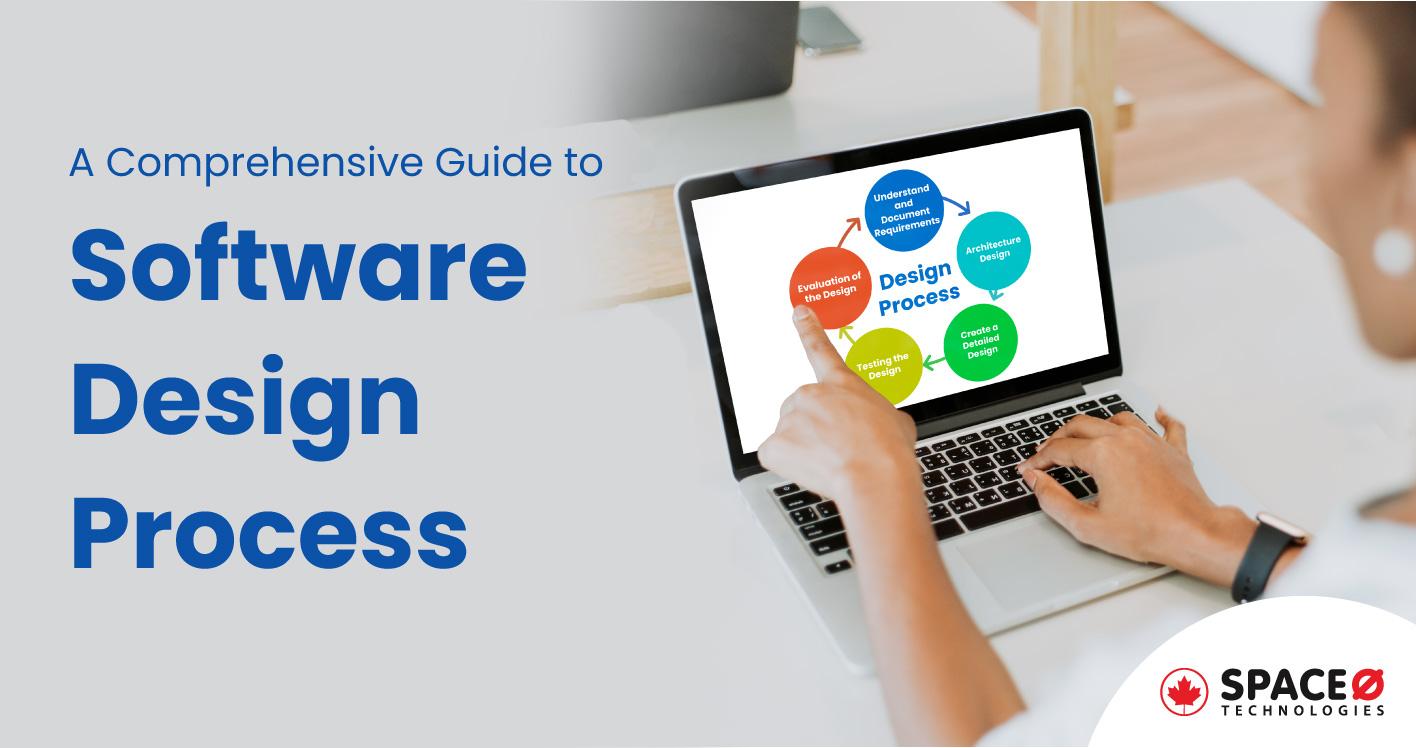
A Complete Guide to Software Design Process in 2025
Whether you are a project manager or a stakeholder, ensuring software project design matches requirements is necessary.
When you are developing a large-scale software solution, it becomes easier to maintain for future requirements due to proper software design.
So, how do you ensure that your software project design meets your user requirements?
This is where the following software design process helps you. As a leading bespoke software development firm, we have experience in developing and deploying 300+ custom software solutions.
We understand the importance of software design and its core components. However, software design has multiple stages to accomplish. In this blog, you will learn about the core components of software design.
Table of Contents
How to Design a Software Solution: Follow These 5 Steps
Let’s learn about the software design life cycle that is followed in software engineering.
Understanding and Documenting Your Software Requirements
The first step in designing is having a deep and clear understanding of software requirements. For that, you need to identify the software requirements, paint points, expectations, and the purpose of a software solution.
To collect such information, interviews, surveys, and meetings are conducted with the end-users. This way, you get a better understanding of all the important details about your project requirements. In addition, you can also gather user feedback to consider in your software development.
Based on the collected information, the features and functionalities of your software application are created. After that, documentation of your software application is done in detail. Technically called software requirement specification.
Creating a Detailed Design Specification for Your Software
Before creating a software solution, it is essential to create a blueprint for your software development. Having a blueprint of your software solution helps you to get a clear vision of your software development.
During the design phase, the wireframe of your software solution is created. Wireframes are a visual representation of your software. The main purpose of creating a wireframe of your software solution is to provide you with a visual representation of the user interface of your software solution.
A wireframe consists of the layout and structure of your software’s user interface. This makes it easy for you to understand where each screen of your software solution goes, and how it functions. By creating the wireframe of your software, you save time and effort for your software development in the later stages of the software process. Here is an example of a wireframe.

The design specification includes multiple components which are as follows:
- Diagrams
- Charts
- Flowcharts
- Components
A detailed software design specification includes information like a description of each module, interaction methods between modules, module functioning, and components of a software solution. Next, the architecture of a software solution is created.
Designing the Architecture of Your Software Solution
The main purpose of creating the architecture design of a software solution specifies how the different components of software interact with each other.
Creating software architecture design involves breaking down your requirements into smaller, more manageable components, and preparing a plan to implement your software solution.
As a reliable software development company, we decompose your software requirements into small components that include creating use cases, defining data models, and identifying functional models of your software.
Next, the data flow diagrams are created for your software solution. Generally, DFDs are created to represent the flow of data through a system or process. DFDs allow you to know how data moves through different stages of your software system, how the data of your software will be processed, and where it is stored or retrieved.
The main reason to create DFDs is to detect or identify the defects or inefficiencies in the data flow of your software application. So, the improvement and adjustments can be carried out in a timely manner.
Further, your software design plan gets created to outline how your software solution will be structured in reality. Creating a design plan involves creating high-level architecture, data flow diagrams, and models to illustrate the design of your software application.
Create a Detailed Design for Your Software
As the architecture design of a software solution is created, the next phase that comes here is a detailed design for a software solution. In this detailed design process, the following internal steps are followed.
- Defining data models and their types which will be used to store and access data between different relationships of data
- Defining the user interface of your software solution that includes the layout of screens, the types of controls, and navigation between screens
- Determining the functional components of your software solution that includes the input and output of each component, the business logic, and the interactions between components
- Defining the non-functional requirements that specify the characteristics that include performance, scalability, reliability, and maintainability
UI/UX designers play an important role in designing software solutions as they are aware of the software design principles. By following these principles, the UI/UX designers create an interface that is not only appealing but intuitive, user-friendly, and meets your end goals.
Evaluation of Your Software Solution Design
Ensuring that every component of your software works is necessary. With the help of the evaluation process, make sure your software design components and modules are working fine.
Through the evaluation process, check whether the different components of your software solution are working perfectly fine or not. Checking if each design component is perfectly aligned with others or not. In addition, changes are done to ensure that the design meets the user requirements or SRS specifications.
Each module and component of your software design is in-sync with each other. So, you can resolve crucial issues and problems by ensuring that your software system is well-designed and meets the requirements. With the use of agile software development methodology, the entire process of designing and developing software becomes easy and fast.
Looking to Hire Software Developers for Your Project?
Want to validate your software project requirements? Connect with our experienced software consultants to get a complete roadmap of your software development.

Differences Between Software Design Process and Software Development Process
Here is a table that shows the differences between the software design process and software development based on different factors.
| Factor | Software Design Process | Software Development Process |
|---|---|---|
| Goal | To plan and design the software system | To build, test, and deploy the software system |
| Output | Detailed design specification | Fully functional software product |
| Focus | Architecture and design | Implementation and testing |
| Deliverables | Design documents, diagrams, and specifications | Working code, test cases, and user documentation |
| Skills Required | Software architecture, design, and modelling | Programming, testing, and deployment |
| Timeline | Typically the initial phase of the software development process | The entire software development lifecycle |
| Activities | Requirements gathering, analysis, planning, and design | Coding, testing, debugging, deployment, and maintenance |
| Risks | Incomplete or inaccurate requirements, poor system architecture or design | Bugs, security vulnerabilities, scalability issues, and maintenance challenges |
| Tools | UML diagrams, design patterns, and modeling tools | Integrated development environments (IDEs), testing frameworks, and deployment tools |
Next, let’s learn about the different design tools used for software design.
What are the Different Design Tools Used for Creating a Software Design?
There are many tools available in the market for creating a user interface and user experience for your software solution. Let’s know the top tools used for creating a design.
| Icon Name | Design Tool | Number of Users | Key Features |
|---|---|---|---|
 | Sketch | Over 1 million |
|
 | Figma | Over 4 million |
|
 | Adobe XD | Over 3 million |
|
 | InVision Studio | Over 5 million |
|
 | Canva | Over 20 million |
|
In the next section, you will learn about the frequently asked question related to software development processes and designing software.
Want to Create a Design for Your Software Solution?
Looking to hire UI/UX designers for your project? We have a team of experienced software designers who have experience working with Adobe XD, Figma, and Sketch.
FAQ Related to Software Design Life Cycle
Which are the core principles of design in software engineering?
Here is the list of core principles that helps you to create an attractive design for your software program.
- Abstraction
- Modularity
- Cohesion
- Coupling
- Separation of Concerns
- Encapsulation
- Cohesion and Coupling
Which are the key elements of a design?
The following mentioned elements of design help to convey your visual message.
- Line
- Shape
- Form
- Space
- Texture
- Tone
- Color
Let’s Design for Your Software Solution
You have learned about the complete process of software design. As you saw, creating a design of a software solution is not easy. There are six core steps as well as multiple internal steps that need to be followed to create the design of your software solution.
Depending on the software projects’ design, the software developers further start coding your software applications. Therefore, ensuring the creation of accurate design is important. If you are looking to create a seamless user experience providing software solutions, let’s connect. As a primer software development company, we have experience in developing software solutions from scratch for multiple industries like healthcare, logistics, and transportation.

Looking to Hire Software Developers for Your Project?
Editor's Choice

Cost Optimization in Software Development: Top 8 Strategies That Work

Top Software Development Technologies for Your Business

Custom Software vs Off-the-Shelf: Making the Right Choice for Your Business
All our projects are secured by NDA
100% Secure. Zero Spam
*All your data will remain strictly confidential.
Trusted by


Bashar Anabtawi
Canada
“I was mostly happy with the high level of experience and professionalism of the various teams that worked on my project. Not only they clearly understood my exact technical requirements but even suggested better ways in doing them. The Communication tools that were used were excellent and easy. And finally and most importantly, the interaction, follow up and support from the top management was great. Space-O not delivered a high quality product but exceeded my expectations! I would definitely hire them again for future jobs!”

Canada Office
2 County Court Blvd., Suite 400,
Brampton, Ontario L6W 3W8
Phone: +1 (437) 488-7337
Email: sales@spaceo.ca

